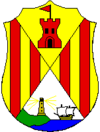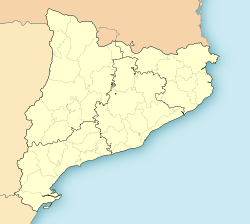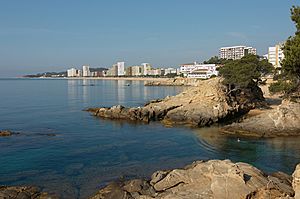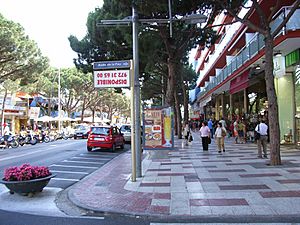Castell d'Aro, Platja d'Aro i S'Agaró facts for kids
Quick facts for kids
Castell-Platja d'Aro
|
||
|---|---|---|
|
Municipality
|
||
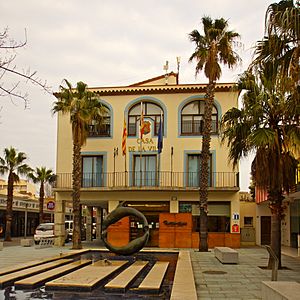
Town hall
|
||
|
||
| Country | ||
| Community | ||
| Province | Girona | |
| Comarca | Baix Empordà | |
| Area | ||
| • Total | 21.8 km2 (8.4 sq mi) | |
| Elevation | 5 m (16 ft) | |
| Population
(2018)
|
||
| • Total | 10,585 | |
| • Density | 485.6/km2 (1,257.6/sq mi) | |
| Demonym(s) | Castellarenc; Platjarenc | |
Castell d'Aro, Platja d'Aro and S'Agaró is a cool municipality located in the middle of the Costa Brava in Catalonia, Spain. It's made up of two main parts:
- Castell d'Aro is an old village built around a medieval castle and a strong church. It's about 3 km (2 miles) inland.
- Platja d'Aro is a lively coastal town with a long 2 km (1.25 mile) beach.
While about 12,000 people live here normally, the population can jump to over 100,000 during the summer! Platja d'Aro started as a small fishing village. Now, it's a popular beach resort, especially for people from Catalonia and Northern Europe who own holiday homes.
Along the coast, you'll find the Camí de Ronda. This is an ancient path that connects the main beach with many smaller, hidden beaches. It's now part of the GR 92 long-distance walking trail, which goes all along the Mediterranean coast of Spain. The path follows the seafront in Platja d'Aro. To the north, it winds along rocky cliffs and crosses beaches to reach Sant Antoni de Calonge. To the south, it goes around the big Marina de Port d'Oro and crosses Platja de Sa Conca before reaching the resort of S'Agaró.
Contents
Where is Castell-Platja d'Aro?
Castell d'Aro is right in the heart of the Costa Brava, about 80 km (50 miles) north of Barcelona. It shares borders with Calonge to the north, Santa Cristina d'Aro to the west, Sant Feliu to the south, and the beautiful coast to the east.
The area sits at the eastern end of the Vall d'Aro. This is a flat plain with the Ridaura river running through it. It's nestled between the Cadiretes mountains and the southern part of the Gavarres mountains. Platja d'Aro was once a tiny fishing village on the road between Palamós and Sant Feliu de Guíxols. Today, it's a big tourist spot with lots of hotels and shops.
A Look Back: History of the Area
Let's explore the interesting past of Castell-Platja d'Aro!
Ancient Times: Prehistory
The very first signs of people living here are tombs from around 2500 BC, found in the Pinell area. Later, around 2000 BC, groups of people settled in the Treumal and Vallvanera mountains. You can still see monuments from this time, like the menhir of Vallbanera and the Cova dels Moros (dolmen).
Roman Era
Roman ruins were found at the Vila de Pla de Palol. These ruins are from the 1st to 4th centuries AD and cover a huge area of 10,000 square meters (about 2.5 acres). This villa was part of a large farm that grew vineyards. They also made clay pottery here, which was then shipped out from the natural harbor of Cove Rovira.
The Middle Ages
From the 9th century, people started to move back into the Vall d'Aro after some difficult times. The first people to arrive were farmers. In 781, Charlemagne gave the land of Vall d'Aro to the Bishop of Girona. The first time Platja d'Aro was mentioned in writing, under its old name Fanals d'Amunt, was in 968.
The origin of Castell d'Aro is the Castle of Benedormiens. This castle was first mentioned in 1041. At that time, religious leaders, local knights, and nobles gave the monastery of Sant Feliu de Guíxols the job of protecting the castle. Their duty was to keep all of Vall d'Aro safe, and Fanals was a very important part of it.
In 1585, a new church was built in Fanals de Baix, which is now Fanals d'Aro. A new village grew up around this church, and people moved away from the older Fanals d'Amunt. The church in Fanals d'Aro was made even bigger in 1774.
Modern Times
For many centuries, there was only one municipality (local government area). In 1858, the area was divided. Romanyà, Bell-lloc, Santa Cristina d'Aro, and Solius became separate from Castell d'Aro and Fanals d'Aro. This is seen as the official start of the two towns, Santa Cristina de Aro and Castell d'Aro.
Between 1892 and 1969, Castell d'Aro was connected to the city of Girona and the port of Sant Feliu de Guíxols by a narrow train line. This old train line has now been turned into a lovely walking and cycling path called a greenway.
A famous architect named Rafael Masó Valentí was hired to design a new neighborhood in S'Agaró. It was planned as a special "garden city" where everything was carefully designed. At the same time, swimming pools were built at Sant Pol, along with fancy hotels like the Monumental Hotel and the Hotel Gavina.
In 1962, as part of new plans to attract tourists, the municipality changed its name from Fanals d'Aro to Platja d'Aro. The local government offices also moved from Castell d'Aro to Platja d'Aro. The town worked hard to become known around the world. For example, in 1964, they offered a free week-long holiday to 50 couples celebrating their 25th wedding anniversary! Another campaign encouraged honeymooners with the slogan "love is found in Platja d'Aro."
In 1970, the City Council, which owns the Castle of Benedormiens in Castell d'Aro, started its first restoration project. The oldest part, from the 12th century, was carefully preserved. In 1978, the first Carnival Fiesta was held, and in 1979, the first democratically elected Council took office. In 1983, parts of the Castle of Benedormiens were changed to create exhibition spaces. In 1995, the old center of Castell, along with S'Agaró, was officially recognized as an important area to protect and conserve by the Generalitat de Catalunya (the government of Catalonia).
Weather in Castell-Platja d'Aro
Castell-Platja d'Aro has a hot-summer Mediterranean climate. This means it has warm, dry summers and mild, wet winters. It's a great place for sunny holidays!
Earthquakes
Castell-Platja d'Aro is in an area where small earthquakes can sometimes be felt. Most of the time, these are just tiny shakes or light vibrations, nothing to worry about.
See also
 In Spanish: Castillo de Aro, Playa de Aro y S'Agaró para niños
In Spanish: Castillo de Aro, Playa de Aro y S'Agaró para niños


